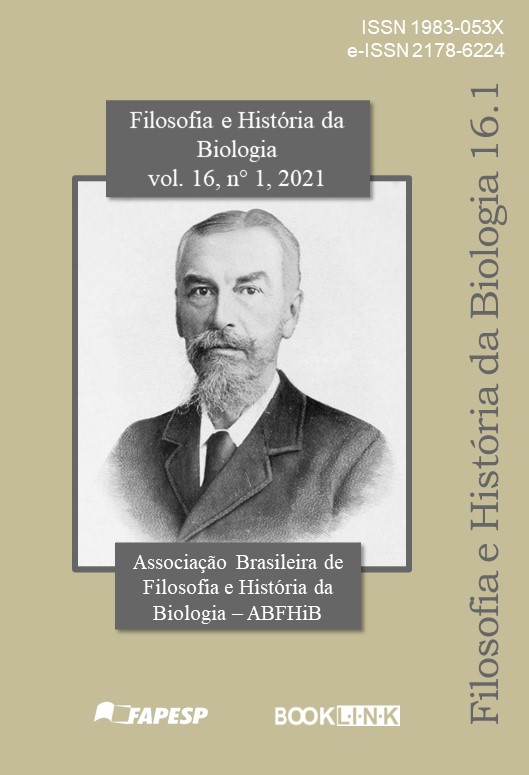Synergy and increasing complexity
DOI:
https://doi.org/10.11606/issn.2178-6224v16i1p1-28Keywords:
Synergy, Complexity, Functionality, Emergence, EfficiencyAbstract
In this paper, I will try to show to what extent complexity can be an advantage for the functionality of organic structures and, therefore, favored by natural selection. I believe that the arguments that I will present could explain a general evolutionary trend, towards the progressive increase of this magnitude. I sum them up as follows. Firstly, greater the number of elements constitute a system, greater are the ways in which they can interact. Second, greater is the number of possible interactions, the more likely there will be synergistic interactions favoring the functional efficiency of the whole; and thirdly, since functional efficiency is a factor favored by natural selection, complexity will increase, indirectly privileged by selection pressure. Before dealing with these simple arguments, I will endeavor to expose, in the most elementary way possible and adjusting them to the framework of this question, the notions of each of the fundamental concepts: complexity, emergence, functionality and synergy, whose imprecise interpretation or appropriation to other contexts, seems to me the greatest threat to the understanding of this proposal.
References
ALLEN, Colin; BEKOFF, Marc. Biological function, adaptation, and natural design. Pp. 571-588, in: ALLEN, C.; BEKOFF, M.; LAUDER, G. (Eds.). Nature’s purposes: analyses of function and design in biology. Cambridge, MA: MIT Press, 1998.
CAPONI, Gustavo Andrés. The Darwinian naturalization of teleology. Pp. 121-142, in: Baravalle Lorenzo, Zaterka Luciana (eds). Life and evolution. History, philosophy and theory of the life sciences. vol 26. Cham: Springer, 2020. DOI: https://doi.org/10.1007/978-3-030-39589-6_8
GOODWIN, Brian Carey. How the leopard changed its spots: the evolution of complexity. London: Phoenix Giants, 1995.
GOULD, Stephen Jay. Full house: The spread of excellence from Plato to Darwin. New York: Harmony, 1996.
HÖLLDOBLER, Bert; WILSON, Edward Osborne. The superorganism: the beauty, elegance, and strangeness of insect societies. New York: W.W. Norton, 2008.
HUXLEY, Julian Sorell. Essays of a biologist. New York: Alfred Knopf, 1923.
HUXLEY, Julian Sorell. Evolution: the modern synthesis. London: Allen and Unwin, 1942.
KAUFFMAN, Stuart Alan. The origins of order. Oxford: Oxford University Press, 1993.
KAUFFMAN, Stuart Alan. At home in the universe. The search for the laws of self-organization and complexity. Oxford: Oxford University Press, 1995.
KITCHER, Philip Stuart. Function and design. Pp. 479-504, in: ALLEN, C.; BEKOFF, M.; LAUDER, G. (Eds.). Nature’s purposes: analyses of function and design in biology. Cambridge MA: MIT Press, 1998.
LITTRÉ, Émile Maximilien Paul. Dictionnaire de la langue française. Paris: Hachette, 1873-1874.
MARGULIS, Lynn. Planeta simbiótico: un nuevo punto de vista sobre la evolución. Trad. Victoria Laporta Gonzalo. Madrid: Editorial Debate, 2002.
McSHEA, Daniel; BRANDON Robert. Biology’s first law: The tendency for diversity and complexity to increase in evolutionary systems. Chicago: Chicago University Press, 2010.
McSHEA, Daniel; HORDIJK Wim. Complexity by subtraction. Evolutionary Biology, 40: 504-520, 2013. DOI: https://doi.org/10.1007/s11692-013-9227-6
MING, Li; VITÁNYI, Paul. An introduction to Kolmogorov complexity and its applications. Lausane: Editorial Springer Science & Business Media, 2009.
MILL, John Stuart. A system of logic, Ratiocinative and inductive. London: John W. Parker, 1843.
OWEN, James. How this cave-dwelling fish lost its eyes to evolu-tion. National Geographic. September 11, 2015 Disponible en: https://www.nationalgeographic.com/animals/article/150911-blind-cavefish-animals-science-vision-evolution
PÉREZ-PÉREZ, Alejandro; GALBANY, Jordi; ROMERO, Alejandro; MARTÍNEZ, Laura; ESTEBARANZ-SÁNCHEZ, Fe-rrán; PINILLA, Beatriz; GAMARRA, Beatriz. Origen y evolu-ción de los dientes: de los cordados primitivos a los humanos modernos. Revista Española de Antropología Física, 31: 167-192, 2010.
POULIN, Robert. The evolution of life history strategies in parasitic animals. Advances in Parasitology, 37: 107-134, 1996.
REYNOLDS, Craig. Flocks, herds and schools: A distributed behaioral model. Computer Graphics, August: 25-34, 1987. DOI: https://doi.org/10.1145/37401.37406
SEARLE, John Rogers. The rediscovery of the mind. Cambridge, MA: Massachusetts Institute of Technology Press, 1994.
WRIGHT, Larry. Functions. Philosophical Review, 82 (2): 139-168, 1973.
Downloads
Published
Issue
Section
License
Copyright (c) 2021 Filosofia e História da Biologia (Fil. Hist. Biol.)

This work is licensed under a Creative Commons Attribution-NonCommercial-ShareAlike 4.0 International License.
The published manuscripts become the property of the journal Philosophy and History of Biology, and the authors accept the terms of this license and agree to assign the copyright for publication, in addition to agreeing with the publication's commitment to offering open access to all of its content. The information and concepts issued in signed papers are the sole responsibility of their authors.


 cademia.edu
cademia.edu
